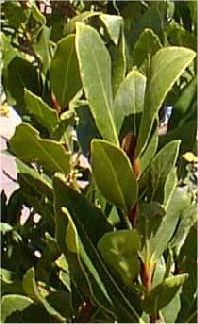|
Gardens Ablaze |
||
|
|
Bay Laurel |
|
|
Additional Bay Information
Medicinal Uses Site Map
Home |
Bay is only hardy to about freezing, or 32 degrees, but might make it through the winter if situated in an area sheltered from the coldest winds. The plant should be mulched heavily, and if it does lose all its leaves, should be cut back to about 6 inches in hopes that sprouts will appear in spring. Likewise, in spring mulch again to keep the roots cool and evenly moist. For potted plants, provide a roomy container and good potting mix, and allow the plant to summer outside with regular watering. Once freezing weather sets in, take indoors and place near a sunny window in a cool room, and water sparingly for best results.
Custom Search
|
|
|
Gardens Ablaze |
||
 Bay
leaves come from the Bay Laurel Tree, which originates in the Mediterranean.
Bay is a finicky ornamental tree that is difficult to propagate and will
only survive in certain climates that have mild winters, such as California
or the deep south. It is not an herb that most of us in harsh winter
regions can grow in our gardens, but it can be successfully grown indoors
if given the proper conditions. It is most likely to succeed if purchased
from a nursery, but it can also be started from seed (difficult because
the seeds tend to mold over the 4 weeks or more it takes to germinate),
or cuttings from fresh, green shoots (which take 6-9 months to root).
The leaves are highly pungent, with a woody flavor, and have a slightly
minty aroma. Bay leaves can be bitter if not used sparingly, so take
heed.
Bay
leaves come from the Bay Laurel Tree, which originates in the Mediterranean.
Bay is a finicky ornamental tree that is difficult to propagate and will
only survive in certain climates that have mild winters, such as California
or the deep south. It is not an herb that most of us in harsh winter
regions can grow in our gardens, but it can be successfully grown indoors
if given the proper conditions. It is most likely to succeed if purchased
from a nursery, but it can also be started from seed (difficult because
the seeds tend to mold over the 4 weeks or more it takes to germinate),
or cuttings from fresh, green shoots (which take 6-9 months to root).
The leaves are highly pungent, with a woody flavor, and have a slightly
minty aroma. Bay leaves can be bitter if not used sparingly, so take
heed.